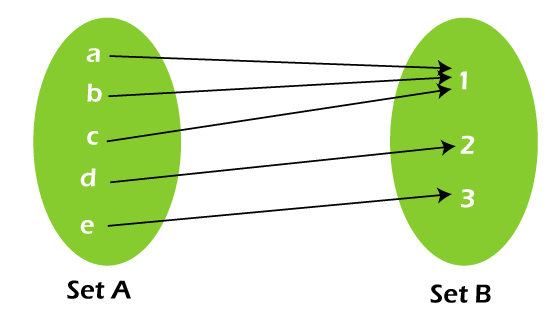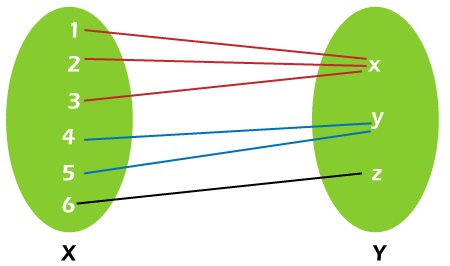Many to one function in Discrete Mathematics
A function will be known as many to one function when minimum of two elements of the domain has a connection with a single element of the codomain. Suppose there are two sets, Set A and Set B, for a function f. In many to one function, two or more than two elements of set A must be connected with a single element of set B. Now we will learn about the definition, properties, and examples of many to one function.
Definition of Many to one function
In the many to one function, two or more than two elements of a set have a connection with a single element of another set. Suppose there is a function f: x → y. For many to one function, minimum of two elements in the domain of this given function, which belongs to set A, will have a connection with only one element in the codomain of the given function, which belongs to set B. Here a minimum of two elements of the domain set must have a connection with the same element of codomain set. For this, we will consider an example in which we have two sets, A and B. Here set A = {a, b, c, d, e}, and set B = {1, 2, 3}. Set A is used to show the domain, and set B is used to show the range, which is described as follows:

The above function f from set A to set B is known as many to one because elements a, b, and c of set A are connected with element 1 of set B. Here f = {(a, 1), (b, 1), (c, 1), (d, 2), (e, 3)}.
If there is only one element in the codomain, in this case, the many to one function will be known as the constant function. In other words, if all the elements of domain have a connection with only one element of the codomain, then many to one function will be known as the constant function. If we are able to utilize each and every element in the range, in this case, many to one function will also be known as the onto function.
To understand this, we will consider an example where we have a function f: A → B. Here set A or domain = {1, 2, 3, 4, 5, 6}, and set B or codomain = {x, y, z}. Here f = {(1, x), (2, x), (3, x), (4, y), (5, y), (6, z)}. The mapping of this function is described as follows:

In the above mapping, we can see that the element 1, 2, and 3 elements of set A are connected with the same element x. Similarly, elements 4 and element 5 of set B are connected with the same element y. This is the way through which a function can have many to one relationship.
Properties of many to one function
There are a lot of properties of many to one function. Some of them are described as follows:
- The domain of the function in the many to one must have minimum two elements, which have the same codomain value.
- In the domain of function, the number of elements must be more as compared to the number of elements in codomain.
- In the many to one function, the codomain will have a minimum 2 domain values.
- As compared to the value of range, the codomain values are always lesser.
- If the many to one function contains only one element of codomain, in this case, we can call many to one function as a constant function.
Example of Many to one function:
There are various examples of many to one function. Some of them are described as follows:
Example 1: In this example, we have a many to one function f. Here f = {(1, a), (2, a), (3, a), (4, b), (5, b), (6, c)}. Now we have to determine the range and domain of this function.
Solution: From this example, we have f = {(1, a), (2, a), (3, a), (4, b), (5, b), (6, c)}.
So from this function, we have
Domain = {1, 2, 3, 4}
Range = {a, b, c}
In this example, we have noticed that the elements of the domain set (1, 2, 3) have a connection with the same element of range set (a). Hence, there is a connection between the elements of domain set with the element of range set of this function, which makes this function many to one function. Therefore, the above function f is a many to one function.
Example 2: In this example, we have a function f such that f(x) = x2. Now we have to determine whether this function is many to one function.
Solution: From this example, we have f = x2. To prove whether this function is many to one or not, we will first assume some values of domain and then find the range from these values. After that, we will understand the type of this function.
If x = 2, then
f(2) = 22 = 4
If x = -2, then
f(-2) = (-2)2 = 4
If x = 3, then
f(3) = 32 = 9
If x = -3, then
f(-3) = (-3)2 = 9
If x = 4, then
f(4) = 42 = 16
If x = -4, then
f(-4) = (-4)2 = 16
For the element of domain x = 2, -2, we get the value of range f(x) = 4. For the values of x = 3, -3, we have the same range value f(x) = 9. Same as for the values of x = 4, -4, we have the same range value f(x) = 16. Therefore, the above function f is a many to one function.
